Norway is a land of fjords, waterfalls, reindeer, rivers, forests and mountains. Almost nowhere in Europe you will find nature as pure as here. Whichever place you choose to explore, you won’t regret it. What is hidden in the country with Europe’s northernmost point? We will show you this in the following article, where we have listed the most beautiful places in Norway for you. As always, practical advice and tips and, finally, general information about Norway are prepared for you.
It is approx. 1600 km by car from Ostrava to the capital city of Oslo. It depends on which path one chooses. The journey to the north is somewhat unconventional, as the sea must be crossed each time. There are several possible ways and combinations to choose from. You can find more information in the practical advice and tips section. If you get to Norway, there is no point in lingering somewhere in the city, but immediately go out into nature. There are 40 mainland national parks and another 7 on the Svalbard archipelago ready for you. First, we will start with one of the most famous places.
Kjeragbolten
Kjeragbolten is truly unique. You won’t find a boulder stuck between rocks like this just anywhere. Will you have the courage to climb a narrow rock with an almost 1000 m deep chasm below you? Even the journey by car to this place is nice. Asphalt in the mountains, the width of one car, which is sometimes covered by sheep, is a nice experience. But you will have to walk about 4 km to Kjeragbolten itself. The path is quite well marked and can be hit even in the fog, which is not an exception here. If you’re lucky with the weather, you’ll have wonderful views of the dark-colored Lysefjord . Standing on a rock with an abyss below is an unforgettable experience. For the way back, you can choose a circular route around the rest of the glacier and the two lakes.


View of the dark Lysefjord and Kjeragbolten in the fog.
Tip: If you want to save on parking fees, don’t drive all the way to the big parking lot, but leave your car in a small bay by the road a little higher (approximate GPS: 59°2’20.952″N, 6°39’4.167″E). Parking is free and it’s a bit closer from here. If you don’t want to pay the parking fee at the following Preikestolen, park about 1 km below the large parking lot at the turns into the forest. It’s probably not completely allowed, but there are more cars parked there, and at the time of our visit, no one was guarding it.
But Lysefjord does not only offer Kjerag. On the other side of the fjord is another well-known Norwegian natural attraction, Preikestolen. If you go by car, you will have to cross the fjord with a smaller ferry.
The pulpit
We will have to walk again to the destination. The marked route starts at Lake Revsvatnet and is again approximately 4 km in one direction. The elevation gain is a little higher this time, but nothing dizzying. There is nowhere to get lost on the route, and you will be accompanied by a considerable number of tourists. Preikestolen is a large flat rock block, from the edge of which you can look down 600 m into the fjord . The experience is really great and you have the whole Lysefjord in the palm of your hand. We recommend climbing the Neverdalsfjell hill along the trails, from where you can see Preikestolen from the top and the surrounding area. You don’t have to go back exactly the same way, you can make a small circuit. Another place to visit is again a world rarity. This is the Troll language.
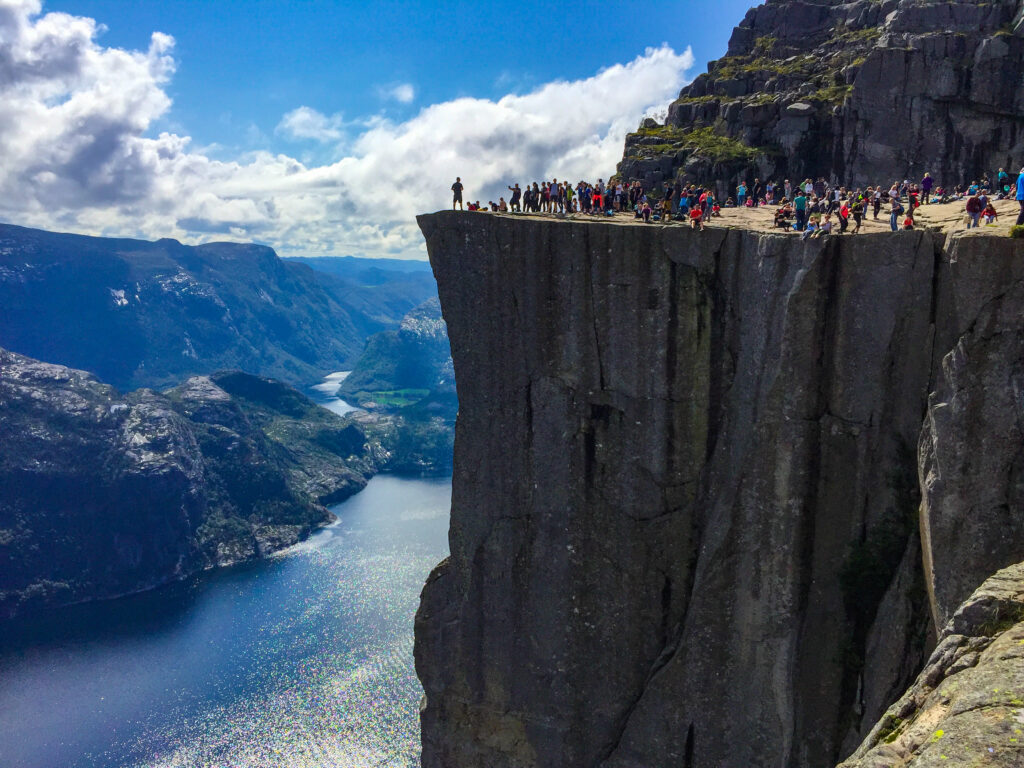
Troll tongue
Be sure not to miss the troll language in your itinerary. Standing on a jutting rock with a view of glacier-capped peaks and Lake Ringedalsvatnet is absolutely unique. But one has to earn this beauty. If you park your car by the dam (free), you are separated from the destination by a 12-kilometer-long route with an elevation gain of 1,000 m in one direction. It’s quite a challenging route in one day, but it’s worth it. If you want to save energy, you can drive to the paid parking lot and cut down a bit of the climb. If you’re thinking of taking the trail along the lake first and then climbing up, don’t do it under any circumstances. In this section there is an old via ferrata that ends a little below the summit and only smooth rock leads up. You would have to go back like we did.
Tip: There is a good camping spot by the dam. You can sleep here and go hiking early in the morning. The sunrise at Troll’s Tongue is amazing.
We have covered Norway’s biggest pearls. Now it wants something calmer. The Valley of the Four Falls is an ideal location.
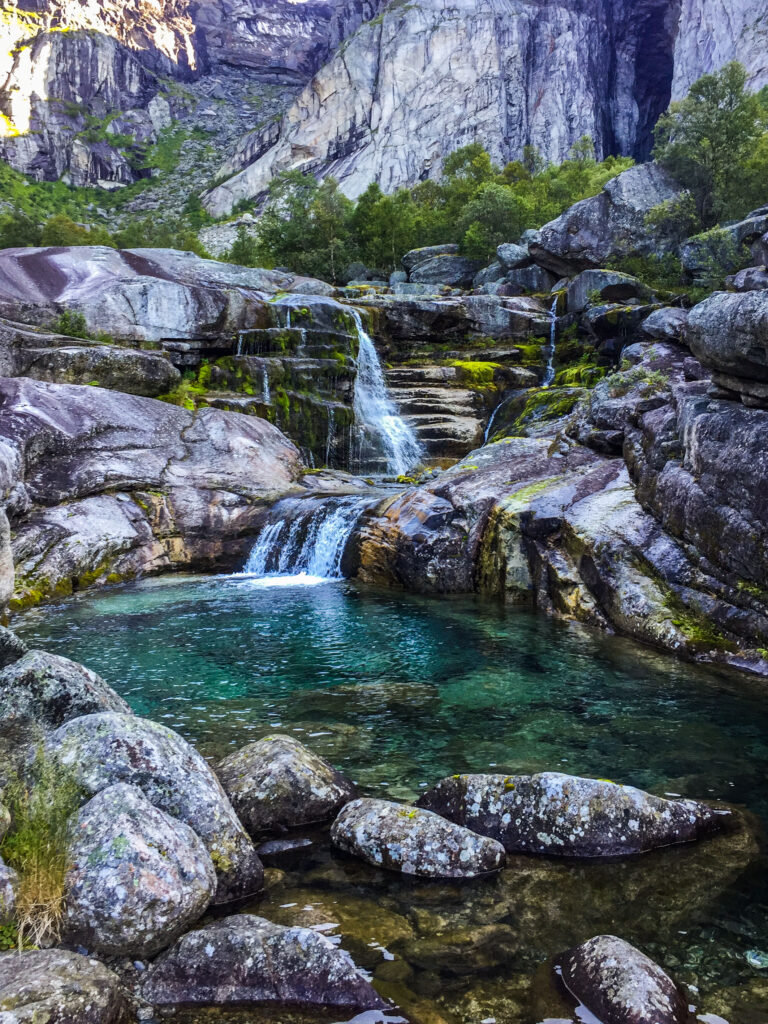
Valley of the Four Falls
The real name of this valley is Husedalen and it is located on the edge of Europe’s largest plateau and the Hardangervidda National Park. In the town of Kinsarvik, we turn into the valley and leave the car in the unpaid parking lot (GPS: 60°21’48.213″N, 6°44’38.741″E). We follow the sign along the Kinso River to the first Tveitafossen waterfall. When you say waterfall in Norway, I really mean a waterfall , and not just any trickle like in the Czech Republic. We climb up along the water pipe and continue to another waterfall, Nyastølfossen, which is even bigger. The third waterfall, Nykkjesøyfossen, follows. It is a bit hidden, but it also has its charm. When we get above this waterfall, we go to the right and cross the wild river over the bridge. From there, stick to the paths along the water and it’s not far to the last waterfall, Søtefossen. In our opinion, he is probably the most beautiful.


Tip: On the right side of the Søtefossen waterfall, you can go up the slope. The path is steep and sometimes ropes are stretched to help. You will be rewarded with a view of the entire valley, the surrounding mountains, the lake, and if you have the courage, you can climb directly above the roaring waterfall. The ascent is only suitable for more experienced hikers.
The route including the climb over the 4th waterfall is about 15 km (there and back) and it is an ideal day trip. You have to return by the same route. That you haven’t seen a glacier yet? It doesn’t matter, even that is not a problem in Norway. Head to Jostedalsbreen.
Jostedals glacier
This glacier is the largest in mainland Europe and is also a national park. We will look at his reptiles. We have two basic options to choose from. The most frequently visited is the Briksdalsbreen slide . We will drive through the nice valley around the Oldevatnet lakes to a paid parking lot (50 NOK/car – year 2017) with a restaurant and souvenir shops. From there, it’s about two km past a wild waterfall to a beautiful view of the glacial slide on the shore of the lake. The atmosphere is somewhat spoiled by tourists who let themselves be brought here in small cars. The view of the glacier is beautiful, but it’s scary to see where the slide was a few years ago and where it is now.
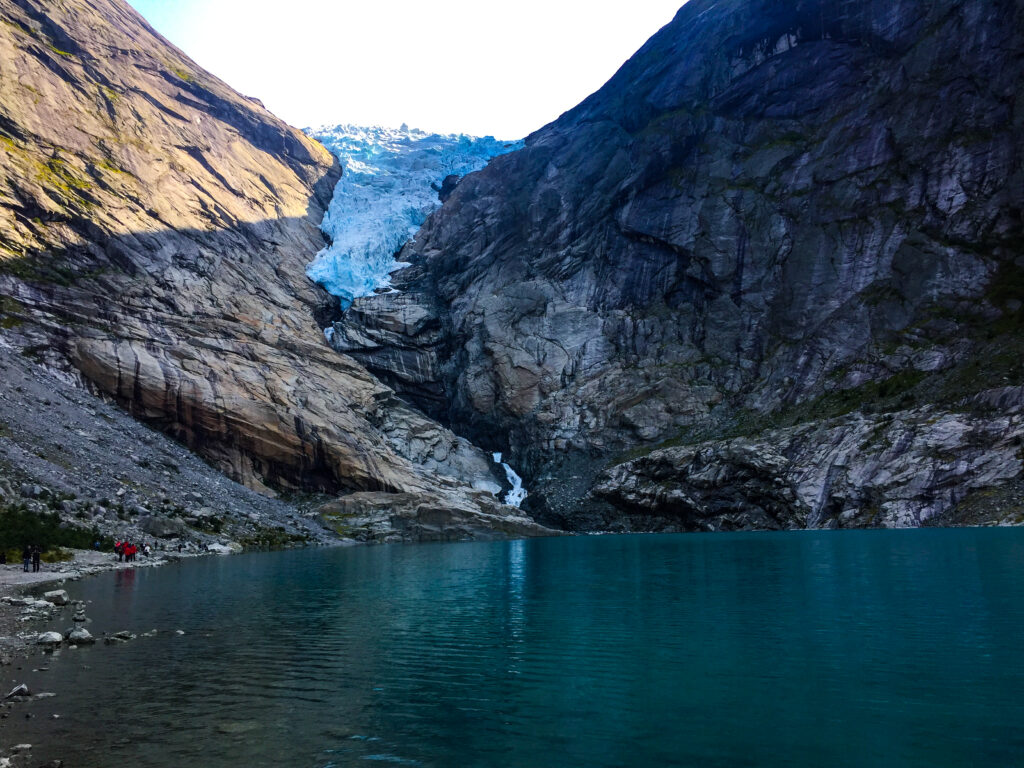
The Kjenndalsbreen glacier slide , located in the adjacent valley, is much calmer. You can reach it by a narrow path along Lake Lovatnet and you will have more peace to admire the scenery. So far we have seen fjords rather from a height, so now we will go to one. And why not choose the prettiest of the prettiest? Geirangerfjord is definitely the best choice. But before we descend to it, there is one small view waiting for us.
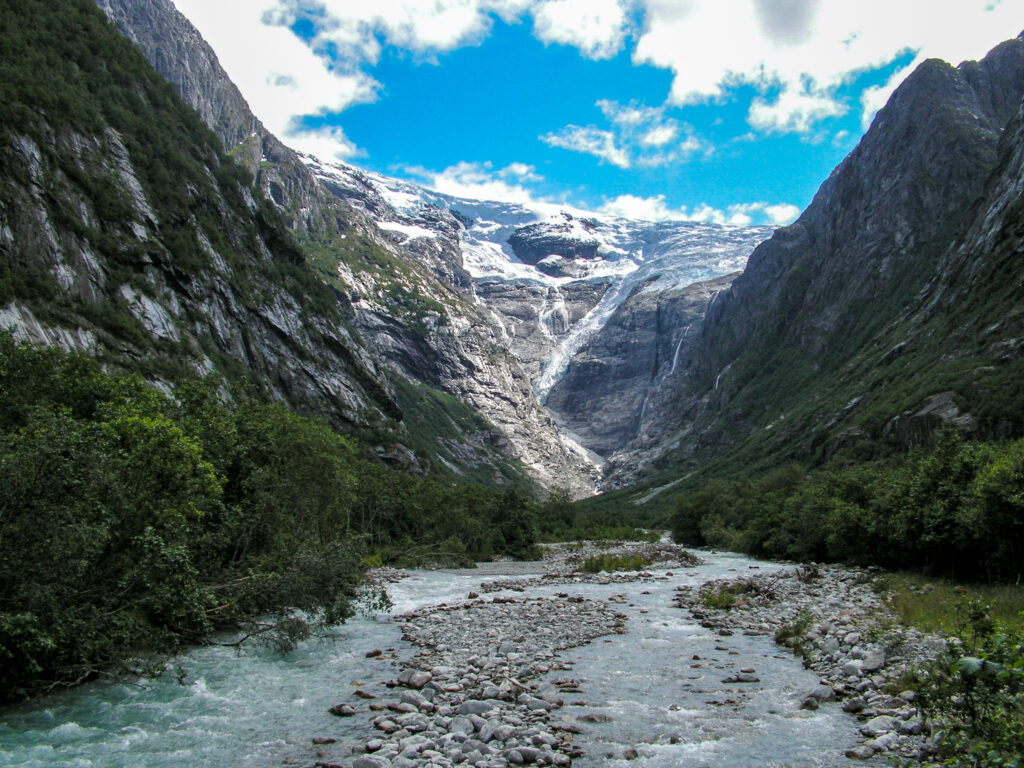
Dalsnibba
Dalsnibba is a 1476 m high peak on which a viewing platform is built. There is no nice hiking trail, but a normal narrow asphalt road. There is a charge for going to this peak (130 NOK/person – year 2017), but it is still worth it. In good weather, the views from the platform are magnificent. You will see the lake from which the ascent began, snow-capped peaks , and a bit of the fjord, to which we descend almost 1,500 meters in height.

Tip: You can also use this article as a great itinerary for a road trip to Norway. Places are listed as they follow each other. The trip begins in the port of Kristiansand, where you sail directly from Denmark.
Geirangerfjord
Geirangerfjord is one of the most beautiful and most visited fjords in Norway. It is also listed on the UNESCO list. After arriving down to the fjord, you have more options to get to know it. You can cross the entire 15-kilometer fjord to Hellesylt by ferry. The price of a one-way ticket is NOK 310/person, a return ticket costs NOK 470. Transporting a car is expensive even by Norwegian standards, the price for a normal car is 1235 NOK. Complete price list including departure times > here <. Cruising the fjord is beautiful. You will see the Seven Sisters waterfall and across from them will be the Suitor who cannot choose between them. You wouldn’t even think that the fjord is up to 360 m deep.
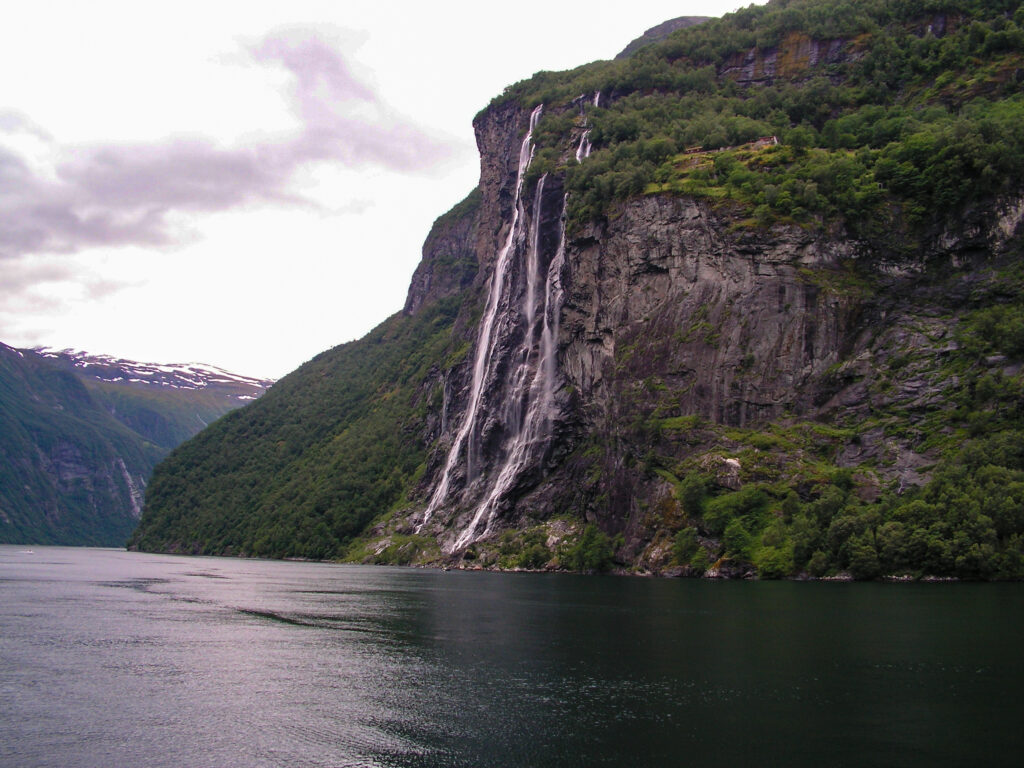
Another option is a short hike to the viewpoint (62°6’46.070″N, 7°7’41.912″E). The route starts from the road on the other side of the fjord and climbs on its left side through the forest. It is not marked, but according to map.cz you can easily find it. After approx. 2.5 km, you will reach the farm on a clearing. From there, continue for 100 m in the same direction, then turn right along the footpaths. The view of the fjord is great. If you don’t feel like pedaling, that’s fine. Even a walk around the sea is nice, and observing a large ocean liner maneuvering in a narrow fjord will keep you entertained for a long time.
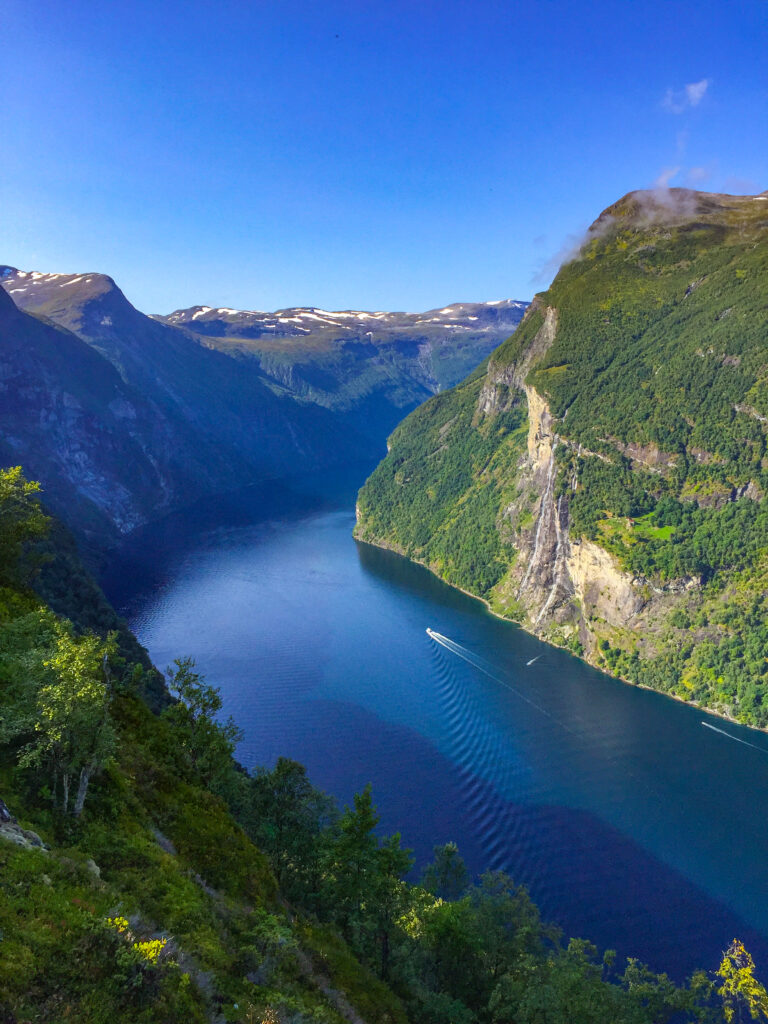
But if you really want a lookout, take the Orlí switchbacks all the way to the Ørnesvingen lookout. From a height of 500 m, you will have a beautiful view of the fjord. This one gets even better if you head up the slope on an inconspicuous trail to a few more viewpoints. If you do the road trip in this order, then the continuation of the Orlí route will take you to the next place.
Trollstiegen
Everything is trolled in Norway. Even road signs. And Trollstiegen is no exception. This is a vantage point from where you can see the legendary Trollstigvegen . Trolí cesta are the most famous European switchbacks, driving through which will excite every driver. At the same time, Trollstiegen is the starting point for hiking to Trollveggen . With a height of 1100 m, it is the highest vertical wall in Europe. The route to it is about 5 km and is well marked. Along the way you will see waterfalls, the entire Troll’s path and glacial lakes. At higher elevations, snow may stick. Snow is definitely waiting for you on Galdhøpiggen too.

Tip: You can sleep under the Trollí on the way. If you turn onto this road (GPS: 62°29’13.941″N, 7°40’13.809″E) you can sleep right at the parking lot by the road or drive a little further into the forest, where you can also sleep in a tent. Of course, the beautiful place is here (GPS: 62°25’20.831″N, 7°39’3.050″E), but at the time of our visit it was so windy that it was impossible to set up a tent.
Galdhøpgen
Galdhøpiggen (2469 m) is the highest mountain in Norway and all of Scandinavia. Part of it is covered by a glacier, so you need a little experience and luck with the weather to climb it. But this is pure tourism, no climbing is needed. Two routes are used for the exit. The first leads from the Spiterstulen hut, is approximately 6 km (one way) and you climb 1400 m. The advantage is that you do not have to cross the glacier. We were interested in the second route, which is half a km shorter and the elevation gain is only 550 m. You can drive the rest to the Juvasshytta hut. The exit is paid (NOK 130/person – year 2017).
On this route, you need to cross a glacier, on which a person should be tied. Surprisingly, the sign with the recommendation is also written in Czech. Of course, it can also be crossed without equipment, but you will risk falling into a glacial crevasse. A couple of them along the way to see them. At the top there is a hut with small refreshments, but it may not always be open. If you want, you can also conquer the opposite second highest mountain in Norway – Glittertind (2464 m).
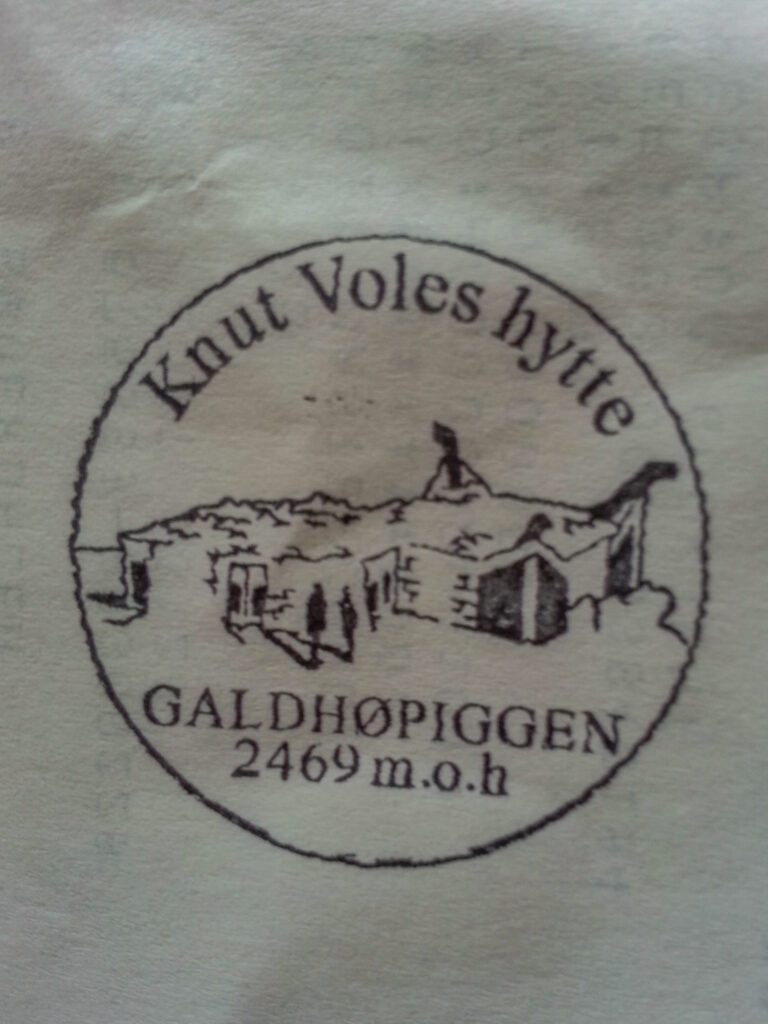
Tip: If you are going through the town of Lom, make a short stop. The local church, waterfall and natural open-air museum with traditional Norwegian houses are worth seeing.
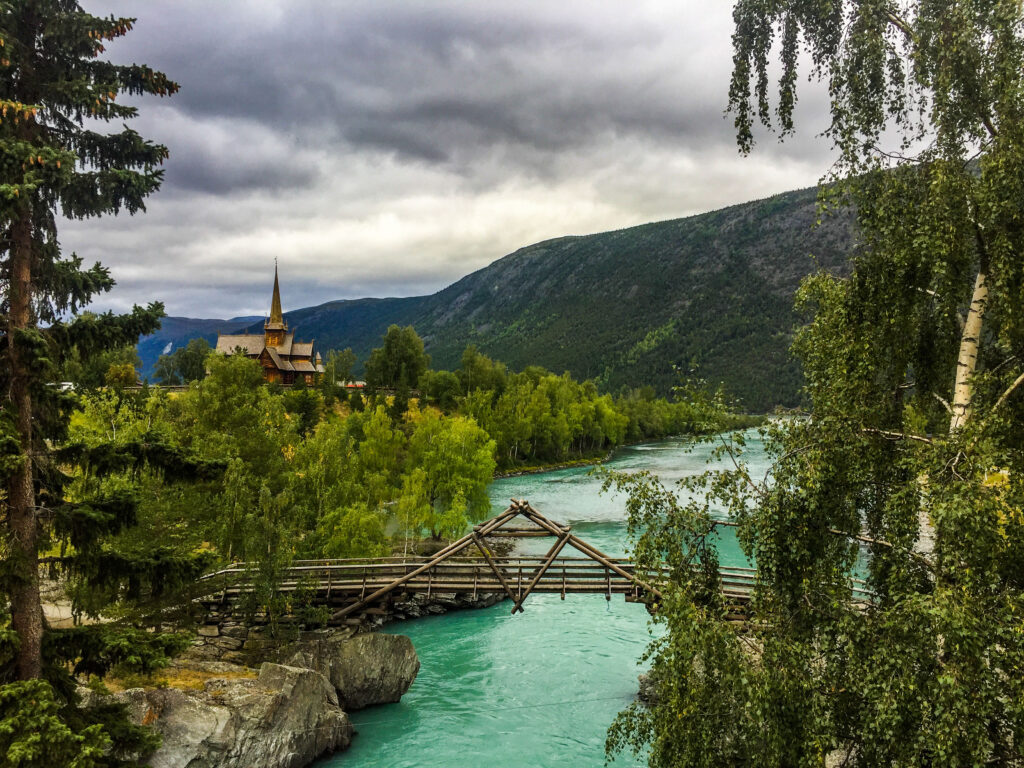
Besseggen a jezero Gjende
Another beautiful place in the Jotunheimen National Park is the Besseggen ridge. The hike along this ridge that extends above Lake Gjende will simply captivate you. Leave your car at the Gjendesheim parking lot and take the boat to the port of Memurubu. The approximate price is 170 NOK/person. Complete prices, including the timetable, can be found > here <. You can walk back along the lake from Memurubu, but it’s much better to climb the ridge and walk back. The Besseggen ridge , which was used by the world-famous writer Henrik Ibsen in his work Peer Gynt, is truly beautiful. From a height of up to 1700 m, you will observe Lake Gjende, located 700 m lower, and Lake Bessvatnet , located 300 m lower on the other side. If you don’t want to spend money on a boat, you can choose an economical option. Along Gjende we will reach approximately below Lake Bessvatnet. From there, a well-trodden path leads directly up to the ridge. As we ascend, we will be almost between the two lakes. But the ascent is quite steep and not well marked.
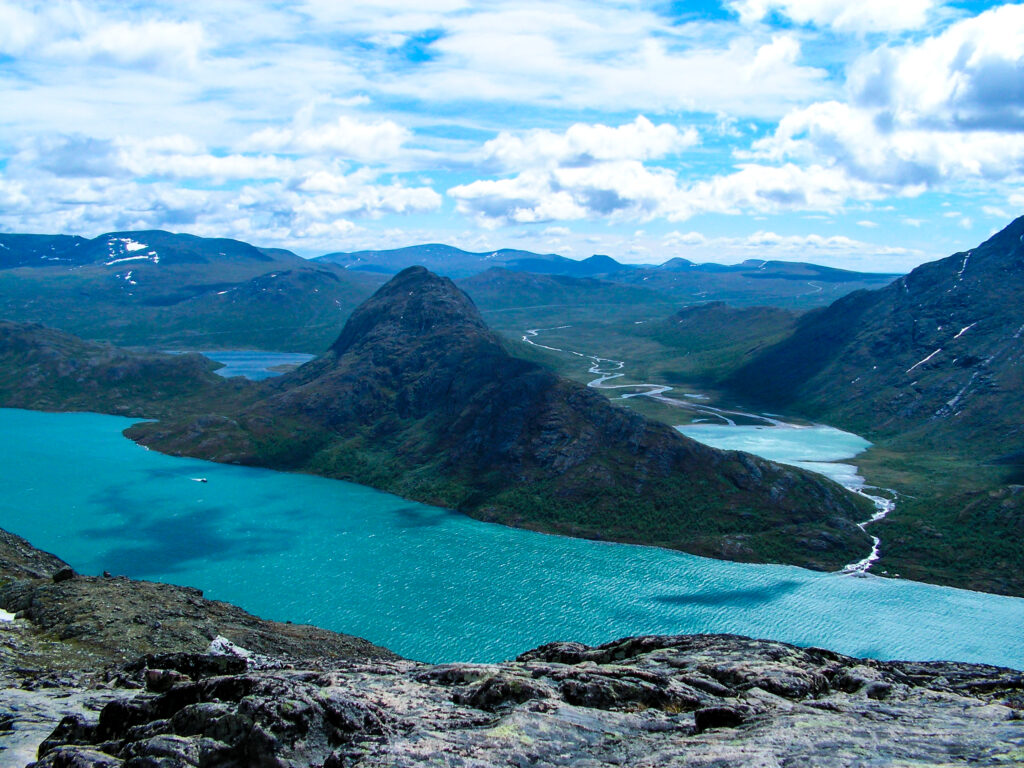
Vettisfossen waterfall
In Norway, there is a waterfall on almost every corner. Sometimes you just come across it on the side of the road without expecting it. Enormous masses of water tumble from high rocks and burrow their way through valleys. But one of them is the king of waterfalls . With a height of 275 m, Vettisfossen is the highest free-falling waterfall in Norway that is not regulated. You can recognize him from both sides. Park your car for free above the village of Øvre Årdal (GPS: 61°20’33.889″N, 7°52’41.051″E). The beautiful Hjellefossen waterfall awaits you right next to the parking lot. Follow the sign and continue along the Utla River to the cottage settlement. From there you can take the left path under the waterfall or the right one to climb to the viewpoint above it. There are nicer views of the waterfall with the upper variant, with the lower variant you will go around the suspension bridge over the wild river, about which we have a video (link). The total route via the upper lookout is approximately 15 km, the lower option is 2 km shorter.
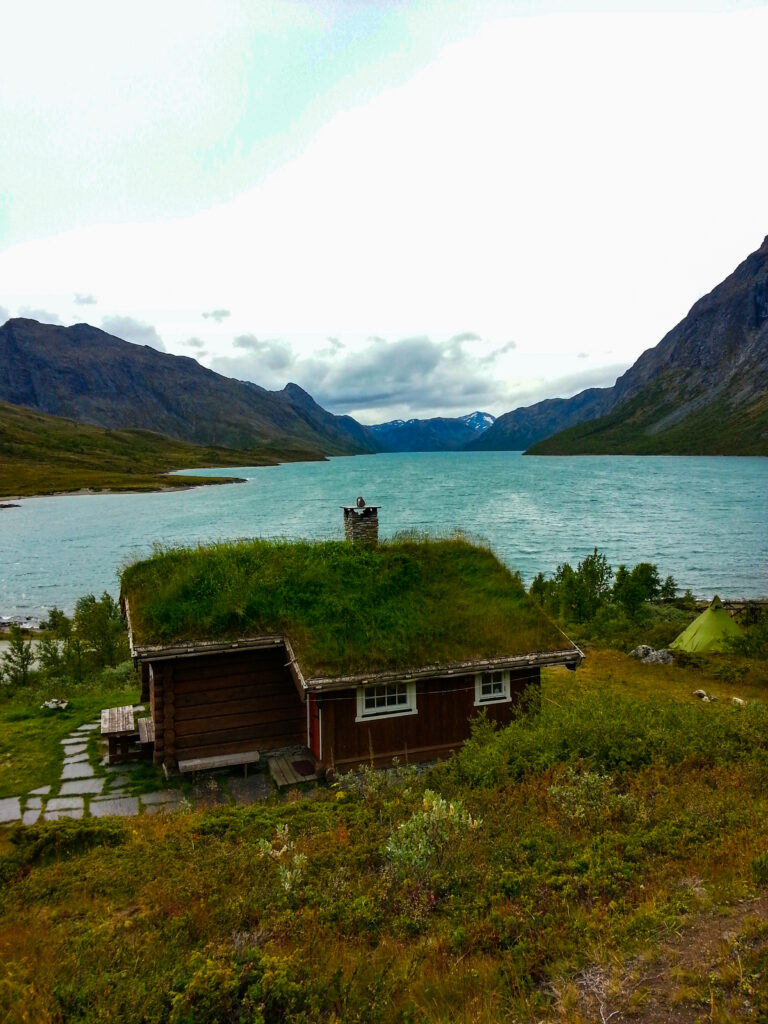
If you go to Øvre Årdal by car, take at least one route around Lake Tyin . The car will sweat up such hills, but it is one of the most beautiful roads in Norway. There are so many natural attractions and beautiful places in Norway that it makes no sense to walk around the cities and monuments. But you should visit the capital Oslo.
Oslo
Oslo is a nice, clean, modern city. What else can you expect from the Norwegians? You can start your tour of the center at the opera house . It is built in a very unconventional style and from its roof you will have a view of the city. The building can accommodate 1,356 seated spectators and in 2009 it was even awarded an architecture prize. If we go around the bay, we reach the Akershus fortress . The fortress is still used by the army, but it is partially open to the public. It contains, among other things, the tombs of several members of the royal family and two museums with a military theme. From the walls there is a view of the harbor and the center of Oslo.
After the promenade we reach the Town Hall (Radhus). A carillon with 49 bells is located in one of the two 66-meter-high towers. The large clock weighing 200 kg is interesting. The National Theater and the Stortinget parliament building are located a short distance behind the Town Hall . If we go along the street Karl Johans gate, we will reach the Royal Palace. It is the current residence of the royal family. Every day at 1:30 p.m., there is a 20-minute changing of the guard in the square in front of the castle. If the King is present, the music of the Royal Guard accompanies the ceremony.
Tip: You can park for free at the Holmenkollen ski jumps or on the Bygdoy peninsula. Nice accommodation can be found in the Bogstad campsite. More info > here <
Do you know Gustav Vigeland?
Don’t miss Frogner Park during your visit to Oslo . The park is freely accessible and contains 214 original sculptures designed by the sculptor Gustav Vigeland (1869–1943). The park was populated by them gradually from 1927, and only in 1943 was the entire world-unique work completed by erecting a central granite monolith 17 meters high and with 121 human figures. If you want to see the city from above, head to the Holmenkollen ski jumps . Today’s form is preserved from the 80s. A ski museum has been made in the ski jumping tower, including a view of the entire city. The basic entrance fee is 150 NOK/person, more info > here <. If you’re interested in other museums, head to the Bygdoy Peninsula. There are several museums here not far from each other. Probably the most interesting of them is the Fram museum, which tells the story of polar expeditions. You can also visit the Kon-Tiki Museum or the Viking Ship Museum. There is also a nice view of the city and incoming ships from the museums.
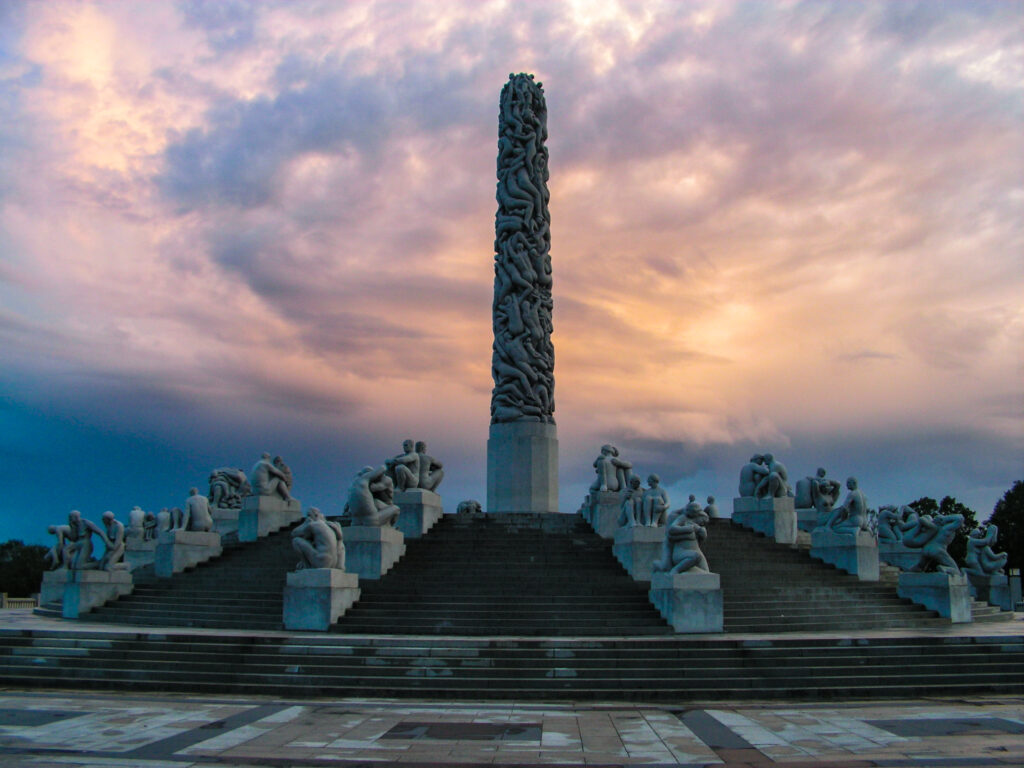
In our opinion, those would be the most beautiful places in Norway. They are our favorites and we will always be happy to come back here. Below we have prepared some practical information about Norway for you.
Practical advice and tips
Transport
You can get to Norway either by land from Sweden or directly by ferry from Denmark. There are several options to choose from. Only one of them is without ferries, after the Storebælt and Oresund bridges , which lie between Sweden and Denmark. This option is the longest in kilometers and usually the most expensive, as both bridges are tolled (you can find detailed prices exactly for your car here: > Storebælt <, > Oresund <). On the other hand, both bridges are an architectural rarity and driving over them is an experience.
Ferries to Norway
Much more often, different ferries are used for the trip to Norway . There are many options to choose from, with the most famous ones being from Denmark directly to Norway: Hirtshals – Kristiansand (approx. 3 h sailing time), from Germany to Sweden: Rostock – Trelleborg (approx. 6 h sailing time), or from Germany to Sweden via Denmark: Rostock – Gedser and subsequently Helsingor – Helsingborg (approx. 1.5 ha 20 min of sailing). It is also possible to sail to Sweden from Poland or directly from Denmark. There are really many variants. When choosing, we recommend comparing the prices of ferry routes, individual companies, as well as the cost of kilometers traveled. The prices of long cruises do not differ much from short ones, while the opposite is true for a car. A minimum of 100 euros must be calculated for one trip across the sea .
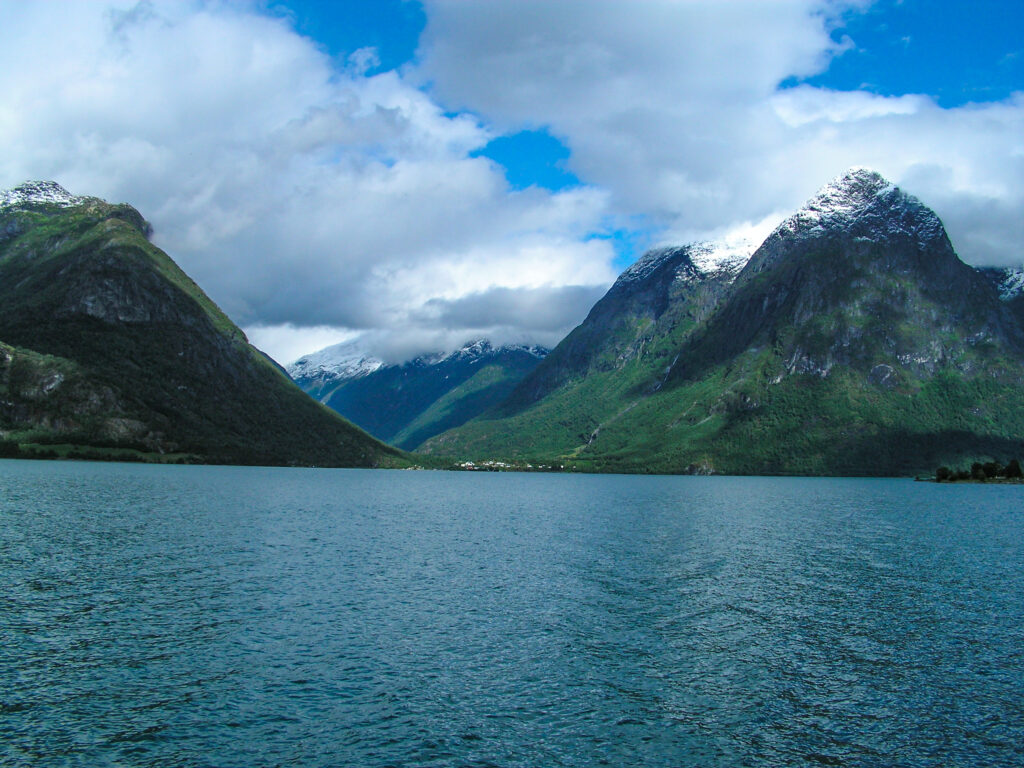
Toll roads in Norway
The advantage is at least the toll-free highways, which are free up to Norway. The only exception is the Svinesund bridge between Norway and Sweden, which costs NOK 20 to cross (more info > here < ). In Norway, paying for travel is a piece of cake . Only certain sections of highways, as well as ordinary roads, are tolled. Payments are collected using unmanned toll gates. Before arriving in Norway , it is necessary to register in the > EPC system<. When you pass through the tolled section, you will automatically be issued an invoice, which can be paid immediately with your registered bank card. The issuing of the invoice is not immediate, it usually takes around a month and depends on the area in which the section is located. For more frequent or longer trips to Norway (more than 3 months), it is advisable to register in the autopass system and purchase an On-Board unit for a refundable deposit of NOK 200. You place it behind the windshield like a bus. More info about the autopass system > here < . The road tolls of all European countries are clearly recorded on this > page <.
Driving in Norway
Driving in Norway is very comfortable . There is no hurry and Norwegians are very disciplined both in driving and in everyday life. The maximum permitted speed outside the village is 80 km/h. Even on the highway, you won’t accelerate much, because the upper limit of 110 km/h is often reduced to 100 km/h. It won’t limit you on narrow roads and switchbacks with views of the fjords, but on straight sections it starts to bother you after a while. However, watch out for frequent section radars. Fortunately, they are branded. Crossing the fjords is not the last transport diversionin the western part of Norway. More than once it happened that we had to cross the fjord by ferry because there was no other way. Fortunately, it runs very often (it always left within half an hour) and there is no need to reserve a seat in advance. Prices vary, we usually paid NOK 130 for a regular passenger car and three passengers. Overall, driving a car in Norway is beautiful, you will experience a lot of interesting tunnels, bridges and scenery.
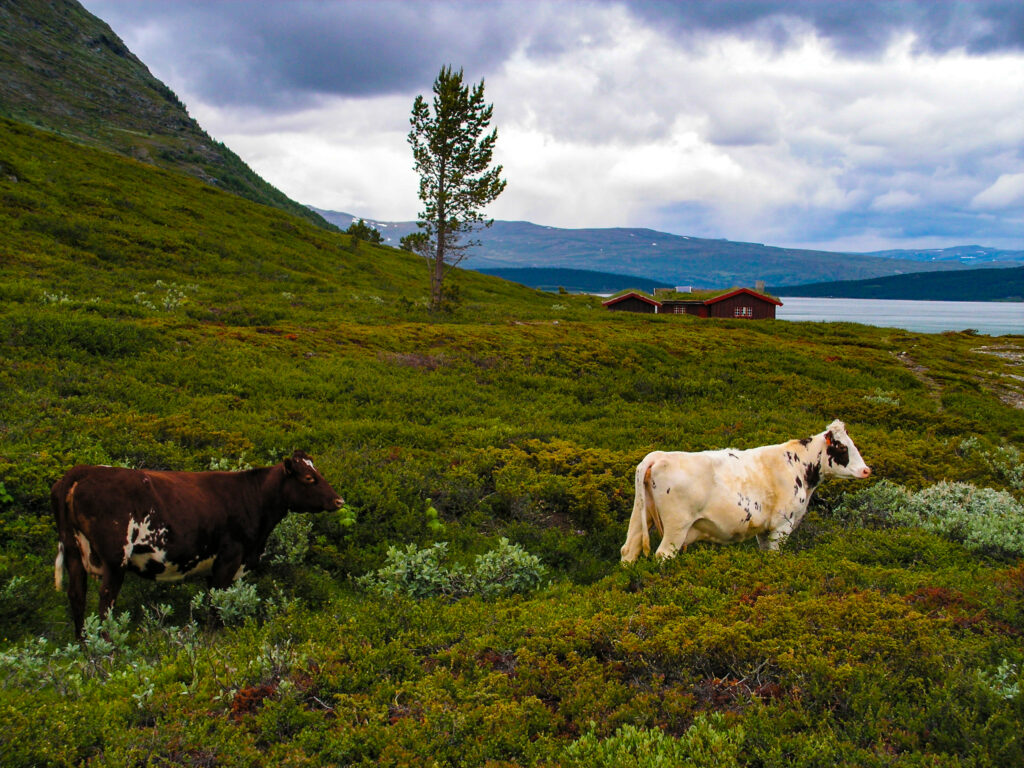
Eating and alcohol?
Eating out in Norway is not cheap . Prices are usually 3 times more expensive than here. We solved it by packing the entire suitcase with food. But if you look a little, you can find cheap raw materials. Especially in Kiwi, Coop and Rema stores they have cheap bread (kneipp), sausages, vegetables and more. Here you will also find significantly discounted goods that have expired. Norwegian jams are a real rarity, which are cheap even by our standards and taste like fresh fruit with sugar. When planning your shopping, pay attention to the opening hours, which are shortened on Saturdays and closed on Sundays. You can look for mushrooms in August. You will trip over them in the right places. This applies to all of Scandinavia. If you decide to empty your wallet and go to a restaurant, then you certainly won’t spoil anything with fish. Norwegians are masters of fishing, and salmon or cod dominate the plates.
Alcohol is the problem in Norway. Due to prohibition , you can only buy it at the stand of the Vinmonopolet monopoly. But there are not many shops and the prices are high because of the tax. If you’re interested in local ingredients, try akvavit . But the cumin-flavored distillate is not for everyone. Beer is also low-alcohol in Norway, but you can also buy it in a normal store. You can also find Czech brands here. When importing your own alcohol, observe the permitted limits or hide it well.
Tip: If you want a good cheap beer, try to find a Czech tour bus somewhere . If you make sad eyes, maybe the drivers will sell you. But do it very discreetly, because the illegal sale of alcohol is very severely punished in Norway and the police are uncompromising.
On the other hand, it is easy to get drinking water for free in Norway. Millions of liters of pure water flow from the mountains at every corner. So you don’t need to carry large supplies of water for hiking , because you can get it almost anywhere. Of course, in compliance with certain principles. Camping is also connected with an unlimited supply of water.
Camping and weather
Norway is perhaps the best country in Europe for free camping . You can sleep almost anywhere, even on private property. You only need to be about 150 m from the building. But it is useless to count meters. There are countless beautiful places in nature where you can sleep in Norway. Tenants and owners of motorhomes will come to their senses here. Another advantage for free camping is frequent public toilets . You can find them at many rest stops or ferry boardings. During our visit, the toilets were always clean and free.
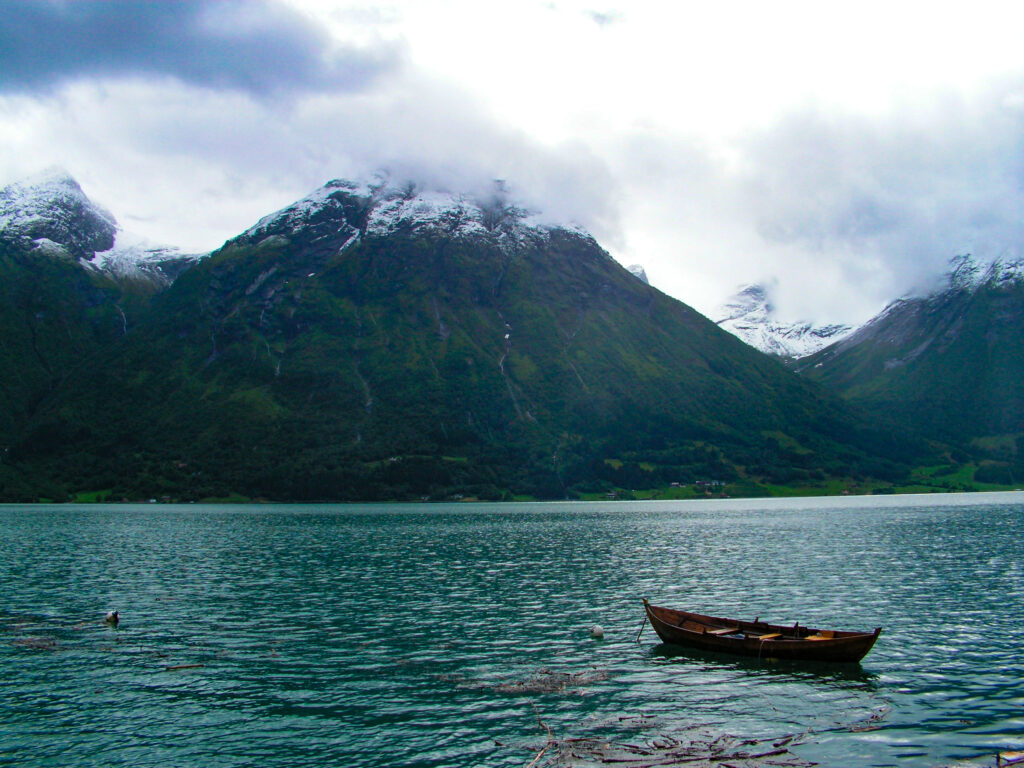
You can use rivers and lakes for swimming. But water is usually only for the hardy. Beware of starting a fire . This is prohibited every year from 15 April to 15 September. We didn’t know about this ban and, among other things, we also made fires on the shore of the Geirangerfjord. We were lucky and no one said anything. The possible fine would be high. Norwegians also have a wide range of campsites. They are of course clean and well equipped. You can use both places for a tent and cabins. The disadvantage is the paid tokens for hot water . In Norwegian weather, a warm shower comes in handy.
The weather in Norway is understandably Nordic. Winter lasts a long time here and even in summer it is not a glory. Frequent rains are the order of the day, which can make life unpleasant especially for tenants. In the higher elevations, you can also regularly encounter snow in the summer. Good waterproof clothing or raincoats are recommended for everyone . Waterproof shoe covers especially for cyclists. But it’s not as bad as it seems. You will definitely experience sunny days when you will sunbathe by the lake. The last piece of advice for traveling to Norway is to pack repellant. Due to the humidity, the local mosquitoes are very active and resistant to winter.
Did you like this article? Do not hesitate to share it on social networks and subscribe to Discover the World on Google News to not miss any articles!